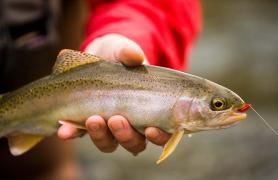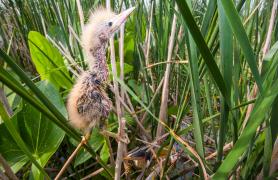Odds are you carry a computer in appointments, and finding places to eat. Did you know you can use your smartphone, tablet, or laptop to get ready for your next hunting trip, too?
More Missourians are using digital technology, including MDC’s online resources, to make their hunting trips more convenient, successful, and fun.
Planning Your Hunts
Before the rise of digital technology, hunters scouted the woods, drew maps, and prepared for hours to get ready for a hunt. Now, hunters use their smartphones and other digital devices to buy their permits, find new places to hunt, avoid trespassing, scout an area, and dodge bad weather on opening day.
Getting Your Permits
When Missouri issued its first hunting permits in the early 1930s, the only way hunters could get them was by going to the county clerk’s office at their local courthouse. After MDC was established in 1937, hunters were able to purchase permits at vendors around the state, including gas stations, convenient stores, and MDC offices. Missouri hunter Chuck Koenig Jr. remembers purchasing his permits at the local convenience stores when he was younger.
“I remember the days I would have to go to a store and purchase my permit and have almost 4 feet of licenses to carry. Thank goodness that’s no longer the case!” Koenig said. “I now can get on the Missouri Department of Conservation’s website or use the MO Hunting App. This is a huge tool for hunters. I now don’t even have to carry a piece of paper for my hunting permit — all I need is my phone.”
Now, he says, technology has improved the permitpurchasing process for the convenience and benefit of hunters.
Finding New Places to Hunt
Koenig also uses his phone’s terrain-mapping technology to find private landowners who may be willing to let him hunt on their land.
“I use a land application on my phone a lot,” he said. “The LandGlide app tells us who the landowner is, where the land is located, and it shows the boundaries of the land. The app will also give us the address and phone number of the landowner, so I could call and talk with the owner to see if I could hunt on their land.”
Mapping technology also lets you see where you are in relation to an owner’s property line, helping you avoid trespassing if boundaries aren’t clearly marked.
“Respecting private property is important,” Koenig said. “Hunters who don’t ask permission or ignore property lines
give all hunters a bad name.”
For their part, some Missouri landowners are welcoming hunters onto their land through the new Missouri Recreational Access Program (MRAP). Featured in last month’s Conservationist, MRAP helps landowners who manage for wildlife offer the public more hunting, fishing, and other outdoor recreational opportunities. To see if there’s a participating landowner near you, visit mdc.mo.gov/mrap.
Finding places to hunt on Missouri’s public lands is a similar web-browsing process. Visit mdc.mo.gov/atlas to search nearly 1,000 Missouri conservation areas, many of which are managed for specific kinds of hunting, such as dove, quail, turkey, waterfowl, or deer. In addition, the Mark Twain National Forest and many national wildlife refuges offer hunting opportunities in Missouri. Your favorite search engine can help you find them.
Scouting the Area
There was a time when hunters would log hours in the woods looking for signs of deer and big bucks on their property. While hunters still enjoy time in the woods, the invention of digital game cameras has lessened the time they need to spend scouring the woods for sign.
“Before game cameras, hunters really didn’t know exactly where deer were on their land — it was really just a guess,” said Andrew White, an avid hunter in northwest Missouri. “But now with game cameras, I can check photos from my phone or computer. It shows me when the deer are moving and if I have any big bucks on my property.”
Game cameras also help MDC biologists with research on all different types of wildlife. They use game cameras to help them with their studies on young and adult white-tailed deer. “Game cameras allow us to remotely monitor deer and other wildlife populations with much less effort and time than typically required by other methods,” said MDC Deer Biologist Barb Keller. “For deer management, we can use them to estimate deer abundance, fawn-to-doe ratios, and buck age structure in certain areas. We also use them on our research projects to time our trapping activities to be most effective.”
Checking the Weather
In addition to helping hunters and managers know what and how much wildlife they can expect to find at a given location, digital tech also helps them avoid bad weather. Koenig’s father, lifelong hunter Chuck Koenig Sr., is in his late 70s. He remembers when you had to call the airport to get the forecast in advance to know what the weather would be like the next day. It was not always the best, or most timely, source of information.
“One time three of us drove from St. Louis to Hannibal to hunt. When we got out of the car, it was zero,” the elder Koenig said. “It was so cold my father-in-law couldn’t hold his gun. So I called the local airport to get the weather report and drove all the way down to Perryville to hunt. It was 15 degrees warmer there, and we were able to hunt the rest of the day. If I’d had more information on the weather, I could have planned that trip better and not wasted any time.”
He added having access to detailed weather reports via smartphone makes preparing for any type of hunt much easier and more efficient.
Communicating With Other Hunters
Just a few years ago, the only way hunters could communicate in the woods was by signal, which could spook game. But now hunters are able to take walkie-talkies or cellphones into the woods and communicate with each other about the hunt.
“I carry walkie-talkies while I quail hunt with my buddies because it helps us communicate with each other about where the dogs are, if the dogs are on point, and where the quail are,” said Koenig Sr. “Walkie-talkies are a great tool for us quail hunters.”
He said walkie-talkies and other communication tools make hunting more convenient in so many ways. It’s even hard to imagine not having some of the communication tools we have now.
Cell phones and walkie-talkies are also very important tools for safety. If there is an accident or an issue while hunting, you can use either of these communication devices to get help immediately. Before there were smartphones and walkie talkies, hunters blew whistles or yelled for help during an emergency — and hoped someone would come to their aid.
Keeping Track of Your Dogs
Quail hunters are benefiting from a new digital technology that minimizes the stress of tracking their hunting dogs when in the field. New global-positioning-system (GPS) dog collars have allowed hunters to focus more on the quail and less on keeping track of their dogs.
White has hunting dogs he trains and uses for quail hunting. He has firsthand experience of the benefits of GPS-collar technology, including remembering a time when there were no collars to help train or locate bird dogs.
“Back in the old days, we didn’t have tracking collars, and you had to keep the dogs in close range while quail hunting. This takes a lot of your focus off hunting and onto the dogs,” White said. “But now with technology, you can have a GPS-tracking collar on your dog and know where it’s at all the time and focus on hunting.”
Celebrating Success
Missouri’s hunting heritage remains strong in many families and communities. It’s still a big event, requiring intimate knowledge of nature and tying friends and family to the outdoors. A successful hunt is something to celebrate, and digital technology has made bragging about your harvest easier, too. Social media gives us plenty of opportunities to post photos and videos. A successful hunt can also mean putting a lot of delicious wild game on the table, and the internet is full of cooking sites with collections of recipes for turning your take into a family feast.
While the spirit and traditions of hunting haven’t changed much through the centuries, preparing for the chase and celebrating a successful hunt in Missouri have gotten much easier, thanks to digital technology. MDC has certificates online you can download to commemorate your first hunt, as well as guidelines to prepare your game for taxidermy. Visit MDC’s Trophies and Certificates pages at short.mdc.mo.gov/Z3S.
Connect With Outdoor Missouri Online
MDC makes getting outdoors and into nature more convenient for all Missourians. From hunting and fishing permits to free mobile apps, conservation area maps, and weekly fishing reports, MDC’s online resources help keep nature at everyone’s fingertips. Explore more at mdc.mo.gov.
Get Hunter Ed Certified
Hunter education is required for most firearms hunters in Missouri, but MDC makes it easy to complete your requirement online if you’re 16 or older. Learn Missouri’s hunter ed requirements, review exemptions, and browse different ways to complete the program at mdc.mo.gov/huntereducation.
Download Free Apps
Three free apps for Android or iPhone include MO Hunting, MO Fishing, and MO Conservationist Magazine. Download all three at short.mdc.mo.gov/Zi2.
- The MO Hunting app lets you purchase and view your annual hunting permits as well as Telecheck deer and turkey permits directly from your mobile device.
- The MO Fishing app helps you get ready for your next fishing trip. Purchase and view your fishing permits and search for nearby bodies of water. View fish attractors, boat ramps, parking lots, and restrooms available for public use.
- The MO Conservationist Magazine app lets you read the Missouri Conservationist on your smartphone or tablet.
Browse the Online Field Guide
MDC’s field guide is a great place to learn more about Missouri’s fish, forests, wildlife, and the many different kinds of habitat they depend on for survival. Check out what to look for right now, or browse by species group and other features. Visit mdc.mo.gov/field-guide.
Share your successful hunts on social media with #mdcbragboard












Also In This Issue


And More...
This Issue's Staff
Associate Editor - Bonnie Chasteen
Staff Writer - Larry Archer
Staff Writer - Heather Feeler
Staff Writer - Kristie Hilgedick
Staff Writer - Joe Jerek
Creative Director - Stephanie Thurber
Art Director - Cliff White
Designer - Les Fortenberry
Designer - Marci Porter
Photographer - Noppadol Paothong
Photographer - David Stonner
Circulation - Laura Scheuler






















